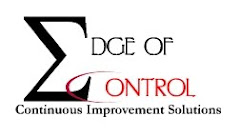As the only fluid plant though, they did not have to compete against anyone else for dollars. They did have to have their project list approved by corporate though and their projects were not to exceed $6 Million. Unfortunately, their current list totalled $10 Million. Somehow the list needed to be whittled down – not an easy task!
Knowing the debate that would occur, Eva Dunro, plant manager, called Edge of Control to facilitate the meeting.
When prioritizing, there are several tools that can be used but for this particular case, we settled on a Characteristic Selection Matrix (CSM). In a CSM the projects are rated individually against the same criteria and the projects with the highest overall score make it onto the final list. Sounds simple but getting everyone to agree on the criteria and the importance of it as well as how each project scores involves a lot of discussion and debate.
Eva and her team decided to evaluate the projects based on the value add the project was bringing to the business. In very general terms, the value of a project can be lumped into 3 categories:
1. Customer Value Added = customer is willing to pay for benefit the project will bring
2. Business Value Added = need to do this to keep operations running, generally from a regulatory perspective (Health and Safety, environmental, fiscal, etc)
3. Customer Non-value Added = no immediate requirement by customer/market but could set up for long term, nice to do
Once the main groupings of criteria/characteristics were determined, the management team then worked on creating sub-criteria and weighting those criteria on a scale of 1-9.

With the evaluation criteria in place, each project was rated individually against the criteria on how well it would fill that value-added need. To make the differences more distinctive, a rating of 1, 3 or 9 was used. Then the weighting of the criteria was multiplied by the rating of the project and a tally was determined.

Once all projects were tallied up, several were immediately removed from the list due to their low-ranking score. Three projects generated a lot of discussion as team members felt that intuitively it was the right thing to do but the projects did not score high on a totally logical criteria basis. Somehow room in the criteria had to be created to capture this important factor. First the team though had to see if there was any way the gut feel could be described and therefore evaluated. Otherwise, criteria called “instinct” or something similar gets added and weighted and ranked the same as everything else.
Finally, Eva Dunro and her team whittled down the list to 12 projects, with a cost estimate of $6.5 Million. Eva left the meeting feeling confident that she could approach corporate and get the extra $0.5 million approved, especially when corporate saw the objective manner in which the list was generated.





No comments:
Post a Comment